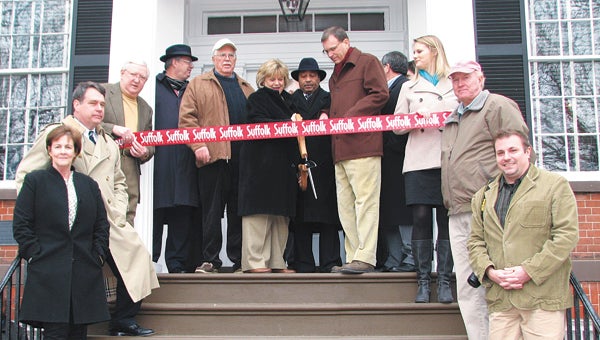Facelift for the Folly
Published 8:18 pm Wednesday, February 12, 2014

City officials join Riddick’s Folly board members and staff in cutting the ribbon on the museum’s new entrance. From left are board members Jane Smith and Marcus Gersbach, Riddick’s Folly director/curator Edward King, Councilmen Charles Parr and Jeffrey Gardy, Mayor Linda T. Johnson, Councilman Lue Ward, Folly Board Chairman Jay Butler, Councilman Mike Duman, and Folly Board members Jenna McKenney, Larry Riddick (a distant cousin of the Riddicks who built the home) and Kevin Sary.
An old building took on new life recently with the restoration of its steps and front entrance.
Riddick’s Folly, a historic house museum located at 510 N. Main St., got a facelift after the original steps, installed with the home’s construction in 1837, deteriorated to the point they could no longer be repaired.
“We thank the city for putting the money into this, because they were in really bad shape,” Riddick’s Folly Board chairman Jay Butler said.
The city owns the Greek Revival-style building, which began its life in the 1830s as the home of Mills Riddick, a wealthy lumber dealer. The home had remained open during the construction, with visitors entering at the back door.
A large fire had destroyed the first building on the site, as well as many others, and Riddick used his insurance settlement to pay for the construction of his new home. Locals dubbed it a “folly” because of its massive size and unusual architecture.
He and his wife, Mary Taylor Riddick, had 10 children who lived to adulthood. When he died in 1844, she moved into a smaller home nearby. The home fell to her children in equal shares, but Nathaniel Riddick purchased his siblings’ shares and moved in with his wife, Missouri. He was a lawyer and used the home for his practice until he built a separate office on the property.
Nathaniel Riddick would go on to serve in the Virginia House of Delegates and as a judge. The Union Army used the house as a headquarters during its occupation of Suffolk during the Civil War, and soldiers’ graffiti still is visible in the home’s upper rooms. Nathaniel Riddick died in 1882.
The home now serves as a memorial to the Riddicks, the Civil War and Suffolk life in the 1800s. It features several permanent and rotating exhibits.
Nansemond Pre-Cast Concrete crafted the new steps, which are New York brownstone style, director/curator Edward King said. Nelson Enterprises was the contractor.
While the work on the steps was going on, volunteer Dempse Burgess helped restore other features of the front entrance, including two lamp posts.
King said the next projects on the museum’s list are the excavation of the cistern on the property and the restoration of the law office, both of which are already underway.






